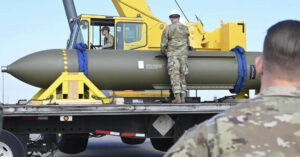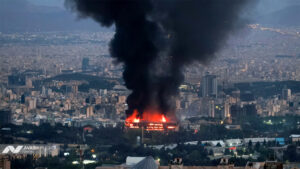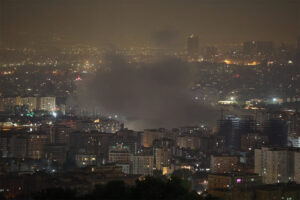Syria was critical for Iran’s influence in the Arab world. For 40 years the Iranians could project power via Syria and Hezbollah, but the collapse of the Assad regime means Syria’s role as buffer and distraction has ended. So, what’s next for Iran?
With Hezbollah in Lebanon severely weakened and Hamas constrained in Gaza, there’s not a whole lot of reliable proxies distracting regional powers. As eyes turn to Iran, it will need to shift its focus to threats that are closer to home. We’re talking Pakistan, Azerbaijan, Iraq, and Saudi Arabia.
As these regional adversaries begin putting pressure on the Iranians, they will likely respond more aggressively than we’ve seen in recent times. This could lead to heightened tensions and potential conflict with the likes of Saudi Arabia.
This marks a larger shift in the Middle East, as regional instability moves eastward toward Iran’s borders.
Here at Zeihan on Geopolitics, our chosen charity partner is MedShare. They provide emergency medical services to communities in need, with a very heavy emphasis on locations facing acute crises. Medshare operates right in the thick of it, so we can be sure that every cent of our donation is not simply going directly to where help is needed most, but our donations serve as a force multiplier for a system already in existence.
For those who would like to donate directly to MedShare or to learn more about their efforts, you can click this link.
Transcript
Hello, everybody. I’m here coming to you from Okura Kuru in New Zealand. Today we’re going to talk about, more consequences of the Syrian civil war coming to an abrupt shift with the fall of the Assad regime. And today we’re going to talk specifically about Iran. Now, Iran’s primary method for intervening in affairs in the Arab world has been through Syria, because here you have a nominally Arab Sunni state in the middle of the region.
Now, Syria has never been ruled by the Sunni Arabs in the modern age. It’s always been by the Assad family, who are a minority called Alawites, which are generally considered to be a heretical sect. But by influencing, affecting, emboldening and empowering the Assad dynasty, the Iranians were basically able to keep everyone on their toes and off balance.
One of the things to keep in mind if you’re a country like Iran, which is basically a mountain fortress, is that, if everyone can concentrate on you, you don’t stand a chance. So the trick for successful management is to make sure people are occupied with other problems. And in a world where the dominant superpower is a naval power, the United States.
You want to keep them locked down with concerns on land somewhere else. And so that’s why the Iranians were always active in Syria. That’s why the Russians were active in Syria. It was just a distraction play more than anything else. Well, now that Syria has fallen, now that the Assads are gone, now that Syria is going to find a different course, Iran is discovering that everything that has worked for in the last 40 years is kind of falling apart all at once.
Hezbollah, which is the militant faction in Lebanon that intervened in the Syrian civil war and has gone to war with Israel a couple times, has basically been beheaded. And the question is whether it can reform at all. And Hamas is now in a box. That’s the militant group in Gaza, and there’s really nothing left, which means that everyone can focus on Iranian issues that are closer to Iran proper, which is a real problem for the regime.
Now, I don’t think that overthrowing Iran is even remotely realistic. This isn’t Russia, where it’s a cluster of people at the top. This isn’t China where it’s a one man show. This is not
Syria where there’s a dynasty. Iran is a theocracy. And so there’s a class of over 10,000 mullahs that rule the country.
And that would be a hell of an assassination program in order to overthrow the political system. But that doesn’t mean there aren’t threats. And that doesn’t mean that there aren’t ways that Iran can be contained and contained. And mostly that’s going to have to do with local issues that have to do with naval prominence and energy policy. Keep in mind that the Persian Gulf is where half of all internationally traded oil is sourced from Iran, even in low times, is going to be a major oil producer and exporter.
So as you crunch down the outer perimeter of where the Iranians have influence, and it moves from Lebanon to Syria to Iraq in the Persian Gulf, it is easier for external powers to pressure Iran right at home. In many ways, this is the worst of all worlds. And what we’re probably going to see in the next few years is Iran being forced to respond in kind within its own inner periphery.
And so that’s less stuff going on in the Levant. That’s less stuff going far away in places like Yemen. And it means having to deal with opposition, both international and local, right around their inner perimeter. Expect to see more going on with Pakistan and the Baluchi rebels that are operate on both sides of the border. With now the Iranians more on the offensive and suffering from Baluchi attacks, rather than empowering them somewhere else.
Expect to see Azerbaijan, which is majority Shia but secular, taking a more pro-American line to contain Iranian power to the north. Expect to see Iraq empowered, which, you know, Iraq is a majority Shia state, but they’re Arabs and not Persians. And in times when Iran tends to get, how should I say this? Insecure, they tend to be very active in what we think of as Mesopotamia, today’s Iraq.
And I would expect that to become much more inflamed, especially as Turkey becomes more involved in the broader region. But the real issue, the real fight is going to be between Iran and Saudi Arabia, because they are the two biggest energy powers. They were the two largest economies in the Persian Gulf. And in any scenario where Iran is on the defensive.
Saudi Arabia has a really big checkbook. And while Sunni militants have hit out at the United States and hit out at Israel and hit out Russia and everyone else, the ethnic group, the religious group that the Sunni Arab militants like okay, are most opposed to are Shia Persians. Most of these groups were originally founded with the intent of taking Iran or its predecessors down a notch or three.
So expect to see a lot more violence as Saudi Arabia starts to write a lot of checks to hem in Iran on all possible points of the compass. And the only way that Iran can return the favor in any meaningful sense is to do a normal war. So, ironically, the end of Iran’s power in the western parts of the Middle East, in places like Syria, is probably going to lead to a more aggressive Iran.
And from their point of view, a defensive Iran. And the only way that they can stop the attacks that are likely to increase upon them is to take the fight to a country like Saudi Arabia. That’s, to be perfectly honest, doesn’t have a functional military on its own. So the next chapter of Middle Eastern history isn’t going to be any more or less violent than the one that came before.
It’s just the violence is going to be further east and closer to Iran’s borders.








